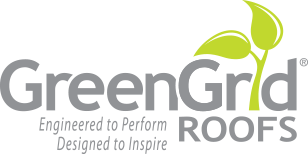1What sizes are available?
Module size is 2’x2’. Tray depths are 2.75”, 4”, 6”, and 8”.
2What is the product warranty?
The GreenGrid modules are warranted for a 20-year period. Plants carry 90 day/1yr/2yr standard warranty options.
3Is irrigation required?
Extensive green roofs typically do not require irrigation for central and northern climates in the US. Many semi-intensive and intensive roof gardens do need irrigation given the different plant varieties used.
4What about wind, fire or other code issues?
See the design guides and references on website
5What type of substrate or growing media is used?
Growing media is an engineered lightweight blend consisting of inorganic and organic components. The mix blends are based on the German FLL guidelines for planning, execution and upkeep of green roof sites. The actual components used vary between regions, depending on availability of resources.
6What types of plants are used?
Typically for extensive (shallow) green roof systems, varieties of sedums or other ground covers are selected. Decorative roof gardens may opt to include perennials or ornamental grasses.
7Can you use native plants?
Most varieties of sedums are considered adaptive, however, native plants can be selected by regional climate. Keep in mind that the rooftop environment is often very different from the native condition, so native plants often are not well suited to green roof applications.
8What is the warranty on plants?
A standard plant warranty is typically 1-year after installation and with documentation of maintenance. Extended plant warranties are also available.
9Do the plant roots need to move between trays?
In short, “no”. The plants with proven track records in the GreenGrid system are not particularly root aggressive. Sedum is a shallow rooted plant that normally grows in rocky outcrops with very little space. The ornamental grasses and flowering perennials incorporated into intensive systems do not need that lateral space either. Remember, the roots follow water and nutrients, and in a green roof mix (gravely and well drained), both are moving vertically much more so than moving horizontally, and the roots will follow.
10Is an underlayment required to be placed beneath the GreenGrid modules?
This depends on the waterproofing system and manufacturer recommendations. Often the waterproofing manufacturer will request that a thin, 4 to 12-ounce fabric be used to protect the membrane during installation.
11Is perimeter edging required to contain the system?
The GreenGrid modules have rigid sidewalls and therefore do not need perimeter edging to retain the growing media. If the layout requires cutting the modules to fit, then edging can be used to retain soil media within the cut trays.
12How best can hardscape features be included with the GreenGrid system?
The 2’x2’ standard dimension of the GreenGrid system is designed to work seamlessly with hardscape options like concrete, wood and other materials that are typically installed using 2’x2’ units as well. Ask us for details on the interface between hard and softscapes.
13Can GreenGrid be placed on sloped roof surfaces?
Standard modules are designed for flat or slightly pitched roof installation up to 1:12. With engineering controls up to a 2:12 pitch is appropriate for the standard modules. Custom modules are available for steeper slopes.
